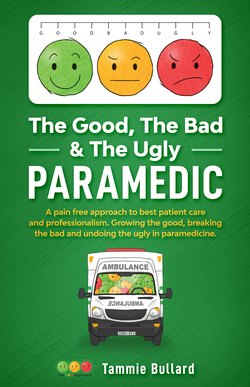Читать книгу The Good, The Bad & The Ugly Paramedic - Tammie Bullard - Страница 6
На сайте Литреса книга снята с продажи.
Guidelines For The Good, The Bad & The Ugly
ОглавлениеWe love our guidelines, or we’re familiar with them at least, so what better way to start than to set out a pattern to follow when reading this book? If you’re like the majority of humans, you will have an inherent desire to just do the right thing. If you truly are like most humans, however, you probably also have a similar level of desire to make life easier.
With this in mind, The Good, The Bad & The Ugly Paramedic is designed to be a friendly companion that supports you in finding your own, individual, healthy balance between the two.
From hereon in, throughout each chapter, unless it’s a direct question or call to action, there will be no further reference to you, the individual. With a clear goal to help the reader self-reflect, without judgment, shame or accusation, taking the team based “we” approach may help us to assess our moral compass more effectively.
Through conversational tone, reading this book should feel similar to that of paramedics chatting in an ambulance, or on station. The type of setting where we can feel safe to share our thoughts, and see how we measure up to our own, and perhaps others’, professional expectations.
It’s not a textbook about skills or knowledge, not by a long shot! We read plenty of those in order to learn our craft, and no doubt still continue to do so. Instead, this one is entirely attitude based and how we choose to manage our professional careers. By highlighting examples of good, bad and ugly approaches through the scenarios we’re about to read, it takes a similar approach to the hands-on training we’re most familiar with, by putting us in the shoes of the paramedics involved. The aim of the game is that we can work towards:
Maintaining good, in fact excellent, standards of patient care as a matter of course, rather than easing off over time.
Taking pride in standing our ground as individuals, sticking to what we believe in, rather than feeling pressured into joining a different crowd.
Inciting passion in new paramedics, and reigniting enjoyment in the role, for those who may have lost their initial spark.
Ensuring continuing attention to safety measures and safe practices, rather than cutting corners and increasing risk.
Enhancing public and interprofessional respect for prehospital care through our choices, rather than damaging the reputation that’s been hard earned over decades.
Preventing unnecessary grievance or legal action from affecting our jobs, and professional registrations, rather than providing reason for complaint.
Cutting out negative inferences towards those doing a good, thorough job, rather than encouraging the positive inferences of being complacent.
Encouraging open, honest and transparent conversations in order to learn from each other, and our mistakes, rather than bluffing that “we’ve got this” in everything we do.
Establishing a community of good paramedics to support and encourage each other on road, in organisations and online, rather than seizing opportunities to criticise or mock.
Formulating consistent, reliable and replicable approaches to our own practice so that it’s just as acceptable for others, as it is for our families, rather than modifying standards to suit ourselves.
Checking in, from time to time, to reassess those standards, rather than remaining oblivious to changing behaviours until they’re out of our control.
In order to reach any of these outcomes, the book itself is structured with a “pick up, put down, then pick back up again” approach. We can read a snippet when we’re short on time, or lose ourselves in the flow from start to finish. It’s easy to skip forward or backwards, without being concerned about missing connections in between, and each chapter summarises why each aspect matters, for a quick refresher whenever we need it.
Like a trusted colleague, who understands our role in depth, we can come home to this book. Re-read highlighted areas that we resonate with, and return to it whenever we want to reassess our practice, or our priorities, on the good, bad and ugly scale.
